|
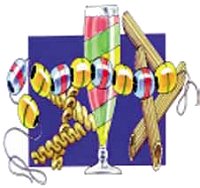
Content Mathematics
Patterns and relationships: Patterns are things that repeat; relationships are things that are connected by some kind of reason. They are important because they help us understand the underlying structure of things; they help us feel confident and capable of knowing what will come next, even when we can't see it yet. Patterns and relationships are found in music, art, and clothing, as well as in other aspects of math such as counting and geometry. Understanding patterns and relationships means understanding rhythm and repetition as well as ordering from shortest to longest, smallest to largest, sorting, and categorizing.
What parents can do:
- Help your children find patterns in designs and pictures, as well as in movement and in recurring events such as the days of the week or the seasons of the year.
- For a hands-on activity try stringing wooden blocks or pasta necklaces into a simple red-blue-red-blue pattern. As children get older they can reproduce and create more complex patterns.
Number sense and numeration: Number sense is much more than merely counting, it involves the ability to think and work with numbers easily and to understand their uses and relationships. Number sense is about understanding the different uses for numbers (describe quantities and relationships, informational tools). Number sense is the ability to count accurately and competently, to be able to continue counting-or count on-from a specific number as well as to count backwards, to see relationships between numbers, and to be able to take a specific number apart and put it back together again. It is about counting, adding, and subtracting. Counting and becoming familiar with numbers will help your children understand all other aspects of math.
What parents can do:
- Count anything and everything! Count real things to help children use their own experience with objects to better understand numbers. Therefore, one of the best math activities you can do with your children is to have them count real objects.
- To help children learn to count accurately and efficiently, up and down:
- -- Point out that counting lets them know how many things there are in a group.
- -- Point to the object as you recite each number name.
- -- Use fingers to count. Put up a finger one at a time as you count it: fingers are tools you always have with you.
- -- Help your children count without skipping numbers or counting something twice.
- To help children learn that numbers are used to describe quantities and relationships, encourage them to:
- -- Sort objects looking for similarities in either color, shape, or size.
- -- Sort objects looking for differences, like which box is bigger.
- Talk to your children about what numbers are used for, such as keeping score in a game, or finding an apartment or street address.
Geometry and spatial sense: Geometry is the area of mathematics that involves shape, size, space, position, direction, and movement, and describes and classifies the physical world in which we live. Young children can learn about angles, shapes, and solids by looking at the physical world. Spatial sense gives children an awareness of themselves in relation to the people and objects around them.
What parents can do:
- You can help your children learn geometry by helping them learn to identify different angles, shapes, and three-dimensional figures. Ask them to identify and describe different shapes, to draw them in the air with their finger, to trace over them with their fingers, and to draw them on paper.
- Children learn geometry best through hands-on experiences. Things they can touch and manipulate are particularly helpful, like blocks, boxes or containers, shape sorters, and puzzles. Even cutting the sandwiches they eat into different shapes and letting them fit them together or rearrange them helps children learn about geometry.
- Geometry and spatial sense help children with directions and finding their way around. Let them climb in and out of boxes, on or around furniture, going under, over, around, through, into, on top of, and out of different things to experience themselves in space.
- As children get older, they play games to find "hidden" triangles, squares, or rectangles that are turned in different ways or have odd shapes. Hidden shapes are ones that do not have flat bases, but are turned in different directions.
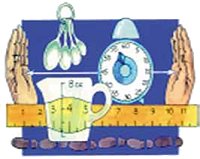 Measurement:
Measurement: Measurement is finding the length, height, and weight of an object using units like inches, feet, and pounds. Time is measured using hours, seconds, and minutes. Measurement is an important way for young children to look for relationships in the real world. By practicing measurement your child will learn how big or little things are and how to figure that out.
What parents can do:
- Standard measurements like inches, feet, and yards are only one way to measure. Let children pick their own unit for measurement-- "Raymond is five cereal boxes tall."
- Many daily activities involve measurement: cooking, gardening, grocery shopping, sewing, and woodworking are only a few examples. Keep your child involved in these chores by talking with them about what you are doing, and by asking them to help you when possible.
- Young children won't understand the concept of time. However,
- -- They can learn that some activities take longer than others. Compare one activity with another to figure out what takes more time. Start by asking simple questions like "Who can stand on one foot longer?"
- -- Set end of time limits. "You can only play for 5 more minutes, then we have to go catch the bus." At first your children won't know what the minutes mean, but gradually the children will understand the idea of time passing.
- -- You can relate units of time to counting by using a watch to time events and counting the ticks on the second hand of the watch by saying, "1 second, 2 seconds, 3 seconds" without timing the event. This uses counting to help children develop a sense of the passing of time.
- -- Start time talk with ideas like "after lunch" or "after dinner" that provide solid milestones for children. It is not until children are older that they understand more abstract notions like yesterday, today, and tomorrow.
Fractions: Fractions represent parts of a whole. A very young child will see something cut into three pieces and will believe that there is more after cutting it than before it was cut. This is typical and should not cause alarm in parents. It is one example of how children and adults think differently!
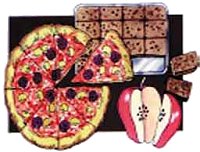 To understand fractions, children need to think about:
To understand fractions, children need to think about:
- what the whole unit is,
- how many pieces are in the unit, and
- if the pieces are the same size.
What parents can do: Many sharing activities help children understand fractions by dividing food, chores, or treats into equal portions. Cutting up pizzas or sharing a pan of brownies are good ways to get children thinking about fractions.
Estimation: To estimate is to make an educated guess as to the amount or size of something. To estimate accurately, numbers and size have to have meaning. Very young children will not be able to estimate accurately, because they are still learning these concepts. They first need to understand concepts like more, less, bigger, and smaller. When children use estimation, they learn to make appropriate predictions, to obtain reasonable results, and they learn math vocabulary such as "about," "more than," and "less than."
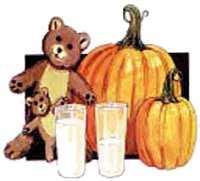 It is important for children to learn:
It is important for children to learn:
- how to use estimation,
- when the technique is appropriate, and
- when the solution is reasonable.
What parents can do:
- Regularly use words such as "about," "near," "approximately," "in between," "around," "more than," and "fewer than."
- To practice estimation, use any daily activity like eating or going to the store. Ask your child to make an estimate of how much, how long, or how many. When you find the actual answer, compare it with the estimate you originally made. This will help your child learn to make reasonable guesses.
- Estimation activities may sound complicated, but they don't have to be. Just take a guess about something-like which one of his friends is the tallest-and then check it out for accuracy.
- To help older children learn estimation, write down the estimate and then the actual count. If you repeat the problem or give a similar problem, children will eventually estimate closer to the real count. It isn't important to get the "right" answer, but to see how close children can come. Help them practice the technique to improve their estimation skills.
Statistics and probability: Using graphs and charts, people organize and interpret information and see relationships. Graphing is another way to show and see information mathematically. Charts, including calendars, can be used to organize everyone's weekly activities. Even older children in elementary school may find it hard to keep track of calendars, but, when adults use them with children, calendars can be helpful tools to learning and understanding how we organize information.
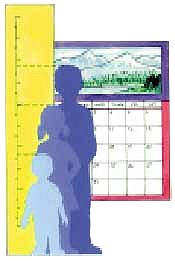
Statistics, like batting averages in baseball, tell stories about our world. We know which player is having the best season and which batter is most likely to hit a home run. Probability tells the likelihood of something occurring.
What parents can do:
- Practically everything you do is "chartable." For example, you can take the stickers from bananas, apples, or pears and place them in columns on a piece of paper. At the end of the week you can count them up to see how many of each type of fruit you ate. Graphs help some children reach a greater understanding of numbers because they can see quantities displayed on paper. This may help them understand math more than looking at numbers on paper.
- Use color forms or stickers to record any regular daily activity. Put a color form next to the phone each time it rings, or have people put one next to the front door to record the number of times someone enters.
Math Activities for Ages Two to Five:
|
|
|